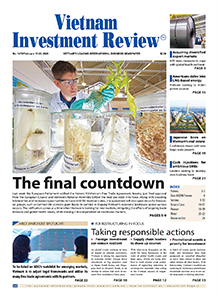Transforming inventory and supply-demand planning in Vietnam
To address the challenges of modern supply-demand planning, companies need to adopt a strategic, technology-driven approach–especially in light of the complexities posed by global trade policies. ABeam’s three-step methodology focuses on optimising processes, streamlining inventory management, and enhancing operational efficiency, enabling businesses to better navigate internal inefficiencies and external disruptions.
 |
The first step is to overhaul the planning process. By identifying existing inefficiencies and aligning the sales, inventory, and production teams, businesses can break down silos and foster cross-departmental collaboration. This alignment ensures all teams work towards a common goal, integrating real-time data and enabling standardised criteria for assessing inventory and sales performance. This foundational change leads to more informed decision-making and smoother operations.
The next step focuses on inventory management, ensuring that businesses strike a balance between supply and demand. Continuously evaluating and fine-tuning inventory parameters–such as safety stock levels and service levels–helps businesses align inventory with actual demand patterns. Regular optimisation of these parameters ensures a reduction in excess stock and minimises the risk of stockouts, especially in volatile market conditions and with fluctuating trade policies. This approach reduces holding costs and ensures a steady flow of goods, preventing disruptions in the supply chain.
The final step involves integrating automation and AI-powered demand forecasting to improve planning accuracy. Predictive analytics enable businesses to generate more precise sales forecasts, ensuring optimal inventory levels across different SKUs. Automation streamlines the sales and production planning processes, reducing the need for manual intervention while providing real-time visibility into inventory, sales projections, and production schedules. This integration allows companies to respond more quickly and accurately to market shifts, minimising disruptions and strengthening the resilience of their logistics network.
Together, these steps provide a comprehensive strategy that helps businesses optimise supply-demand planning, strengthen inventory management, and enhance overall operational efficiency. By implementing this approach, companies can better adapt to current challenges, seize new opportunities, and prepare for future market dynamics.
Case study
A multinational pharmaceutical company with a diverse product range and global operations faced substantial challenges in streamlining its procurement, distribution, and financial reporting processes. Fragmented systems led to inefficiencies, manual tasks, and hindered decision-making, limiting agility. The company needed to integrate its systems and optimise planning processes to improve data accuracy and overall operational efficiency.
To address these issues, the company implemented a comprehensive solution combining SAP roll-out with Business Process Reengineering (BPR) for planning. The SAP roll-out unified supply chain, procurement, warehouse, and distribution processes, reducing silos and ensuring smoother data flow across functions. Simultaneously, the BPR approach redesigned planning processes like demand forecasting and procurement-to-pay, eliminating inefficiencies and aligning them with best practices.
As a result, the company significantly improved supply-chain planning and execution, reducing stockouts and overstocking while optimising procurement and distribution. Financial reporting became more accurate and timely, enhancing operational efficiency. By integrating SAP with a BPR approach, the company overcame operational challenges, optimised key business functions, and positioned itself to better adapt to future market dynamics.
| For each phase of the Deployment Method, streamline the key deployment activities and deliverables into:
|
Addressing supply-chain inefficiencies with Celonis
In today’s competitive market, many companies face inefficiencies in procurement and inventory management. Issues such as poor on-time delivery, excess inventory, and component shortages can significantly impact profitability.
For example, one manufacturing plant is dealing with persistent inventory stagnation. Parts replenishment from headquarters takes five months, and local sourcing is only 60 per cent. Despite placing orders in advance, fluctuating demand leads to excess stock. Another manufacturer is focused on understanding how component shortages affect downstream processes.
Data-driven actions are essential to address these challenges. For example, to improve on-time delivery (currently at 61 per cent, with an industry average of 78 per cent), companies can:
- Reallocate 5 per cent of inventory from the Binh Duong factory to prevent stockouts of Item 'A'.
- Increase credit limits for key customers by over 3 per cent to ensure smoother order fulfilment.
Using a powerful process mining and analytics tool like Celonis, businesses can gain real-time insights, identify inefficiencies, and take corrective actions quickly.
One common challenge companies face is improving on-time delivery while managing inventory efficiently. Celonis helps identify inventory imbalances, such as reallocating stock or adjusting customer credit limits, to improve on-time delivery rates. With real-time visibility, companies can proactively enhance delivery performance. Fragmented planning across departments is another issue. Sales, inventory, and manufacturing teams often operate in silos, leading to inefficiencies. Celonis bridges these gaps by providing end-to-end supply-chain visibility, enabling collaboration based on real-time data, and improving coordination in demand response.
Excess inventory and parts shortages create imbalances that can lead to overproduction or underproduction. Celonis helps pinpoint the root causes of these issues by comparing production data with sales forecasts, allowing businesses to align production schedules with demand. Celonis also optimises material flows across the supply chain. Tools like BOM analysis and Network Explorer help identify bottlenecks and delays, enabling businesses to take corrective actions quickly.
 |
Celonis helps companies respond to immediate challenges and enables long-term operational efficiency. By enhancing visibility and facilitating smarter decision-making, businesses can streamline operations, reduce costs, and boost customer satisfaction in a highly competitive market.
Conclusion: defining clear objectives for effective execution
Improving inventory management and supply-demand planning in Vietnam demands a strategic, cross-functional approach that transcends mere operational adjustments.
Yoshihiro Wake, lead of Transglobal Expansion Frontier at ABeam Consulting Vietnam, said, "Leadership must first define their objectives–whether that’s reducing inventory to improve the Cash Conversion Cycle, developing a flexible strategy to manage inventory amidst volatile demand, or other critical goals. Once the direction is clear, it’s essential to collaborate closely with operational teams to refine and implement the solution."
 |
With a well-defined strategic vision, the next step is to align it with on-the-ground execution. This synchronisation between high-level goals and daily operations is crucial to addressing challenges like fragmented planning and inefficient inventory management, while fortifying the supply chain against disruptions.
By integrating cutting-edge technologies such as SAP, BPR, and AI-powered forecasting into a unified strategy, businesses in Vietnam can optimise their operations, navigate market complexities with agility, and position themselves for sustained success in an increasingly dynamic business environment.
 | ABeam Consulting introduces 'process mining' to Vietnam ABeam Consulting is introducing advanced 'process-mining' technologies tailored for Vietnamese firms, addressing the complex challenges of digital transformation and helping businesses navigate the rapidly changing market dynamics. |
 | Enhancing logistics centre operations with ABeam Consulting ABeam Consulting is at the forefront of building a smarter, more agile logistics operation that keeps companies ahead in this fast-evolving market. |
 | Vietnam’s manufacturing revolution: unlocking smart factory potential with ABeam Consulting ABeam Consulting is helping manufacturers to switch to smart factory solutions and optimise production processes in Vietnam. |
What the stars mean:
★ Poor ★ ★ Promising ★★★ Good ★★★★ Very good ★★★★★ Exceptional
Related Contents
Latest News
More News
- Interschool logistics competition highlights industry-ready skills for Gen Z students (December 02, 2025 | 17:11)
- Vietnam’s business leaders step up to advance responsible supply chains (December 02, 2025 | 16:44)
- Siemens and AIT unveil digital switchboard tailored for high-end clients (December 02, 2025 | 09:11)
- Cyberthreats targeting the 2025 holiday season (December 02, 2025 | 09:00)
- Dassault Systèmes joins forces with European firms to advance sovereign digital Europe (November 30, 2025 | 10:00)
- AEON Vietnam recognised at VIR’s Sustainable Development Conference 2025 (November 28, 2025 | 18:03)
- Saigon Food accelerates global export readiness with translation solution (November 28, 2025 | 11:10)
- Vietnam eyes top Asia logistics hub with digital, green transformation (November 26, 2025 | 16:39)
- Vietnam job market hits new milestone with rising salaries and race for AI talent (November 26, 2025 | 16:21)
- PM urges Ho Chi Minh City to innovate and remain Vietnam’s economic locomotive (November 26, 2025 | 15:29)

 Tag:
Tag:





















 Mobile Version
Mobile Version